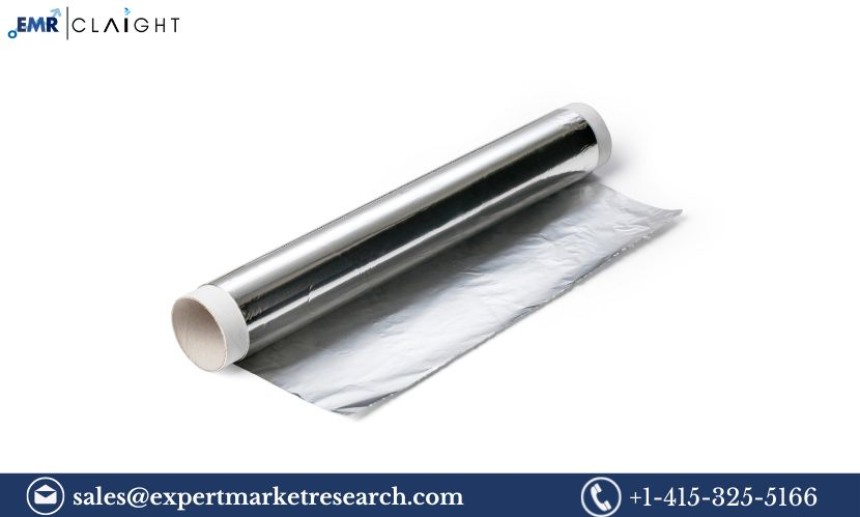
Aluminum Foil Manufacturing Plant Project Report 2024: Processes, Costs, and Considerations
Learn how to set up an aluminum foil manufacturing plant with this comprehensive project report, covering production, raw materials, and market demand.
Introduction
An Aluminum Foil Manufacturing Plant Project Report provides a detailed blueprint for setting up a facility to produce aluminum foil, a widely used material in packaging, food storage, medical applications, and various industrial uses. Aluminum foil is prized for its durability, malleability, and excellent barrier properties against moisture, air, light, and bacteria, making it an essential component in food and pharmaceutical packaging. This project report will cover various aspects, including raw materials, the manufacturing process, plant infrastructure, market opportunities, and regulatory compliance, aimed at guiding investors, entrepreneurs, and businesses planning to establish an aluminum foil production plant.
Overview of Aluminum Foil IndustryThe aluminum foil industry has seen steady growth globally, driven by its versatile applications and increasing demand in packaging industries. Aluminum foil is commonly used for food packaging, household uses (such as wrapping and baking), in pharmaceutical packaging for tablets and capsules, and for industrial applications like insulation and heat exchangers.
The market demand for aluminum foil is driven by factors such as:
- Food and Beverage Industry: The primary application of aluminum foil is in the food industry, particularly for packaging, preservation, and cooking purposes. The growing demand for convenience foods and ready-to-eat meals further drives this market.
- Pharmaceutical Packaging: The pharmaceutical industry increasingly relies on aluminum foil for blister packs and drug packaging because of its protective properties.
- Environmental Concerns: As a recyclable material, aluminum foil is favored in sustainability initiatives, contributing to its growing adoption.
- Construction and Industrial Applications: Aluminum foil is also used for insulation, heat exchange, and as a protective coating for various materials.
Get a Free Sample Report with Table of Contents@
Raw Materials for Aluminum Foil ProductionThe production of aluminum foil requires a few key raw materials, including:
- Aluminum Ingots:
- Aluminum ingots are the primary raw material for manufacturing aluminum foil. These ingots are produced from bauxite ore, refined into alumina (Al2O3), and then processed in smelting furnaces to produce aluminum metal.
- Lubricants and Additives:
- Lubricants are used during the rolling process to prevent the aluminum from sticking to the rollers and ensure smooth operation. Additives like anti-oxidants are also used to protect the foil from damage and corrosion.
- Recycled Aluminum:
- Recycled aluminum, sourced from scrap aluminum or used foil, is increasingly being utilized to reduce production costs and environmental impact. The use of recycled aluminum also reduces the energy required for aluminum production.
- Packaging Materials:
- Aluminum foil needs to be packaged carefully to avoid damage during transportation and storage. Packaging materials include plastic films, boxes, and shrink wraps to protect the final product.
The process of manufacturing aluminum foil is a multi-step procedure that involves transforming aluminum ingots into thin sheets of foil. The following is a breakdown of the key steps involved in the production of aluminum foil:
1. Aluminum Smelting and CastingThe process begins with aluminum smelting, where bauxite is refined into alumina (aluminum oxide), which is then reduced to pure aluminum metal through electrolysis. The aluminum metal is cast into large ingots.
2. Hot RollingThe aluminum ingots are heated to high temperatures and passed through rollers to reduce their thickness. This process is called hot rolling. The ingots are passed through a series of rollers, which flatten and elongate them into thicker sheets. The thickness of the sheets is gradually reduced as they pass through multiple rolling stages.
3. Cold RollingAfter the hot rolling stage, the aluminum sheets are cooled and further processed through cold rolling. Cold rolling is done at room temperature, and it helps in refining the thickness of the aluminum sheets. This stage also imparts the desired mechanical properties to the aluminum foil, including increased strength and malleability.
4. AnnealingAnnealing is a heat treatment process that softens the aluminum after it has been cold-rolled. This is an important step to improve the foil's flexibility and make it easier to manipulate during the subsequent stages of manufacturing.
5. Foil RollingThe aluminum sheets undergo final rolling to achieve their thin, foil-like form. The foil thickness can vary depending on the application requirements, typically ranging from 0.006 mm (for food packaging) to 0.2 mm (for industrial uses).
6. SlittingOnce the foil is rolled to the required thickness, it is slit into smaller rolls of specific widths. These rolls are then packaged and prepared for shipment. The slitting process ensures the foil is cut to the desired size, making it suitable for specific packaging applications.
7. Surface Treatment and Coating (Optional)In some cases, aluminum foil may undergo surface treatment or coating processes to improve its properties, such as corrosion resistance, heat reflectivity, or printing. For example, the foil might be treated with a lacquer coating to ensure it is suitable for food packaging or pharmaceutical use.
8. Quality ControlThroughout the production process, strict quality control measures are implemented. This includes checking the thickness, strength, flexibility, and surface finish of the aluminum foil. Any defects in the foil, such as holes, wrinkles, or uneven thickness, are detected and rectified before packaging.
Plant Design and InfrastructureSetting up an aluminum foil manufacturing plant requires careful planning, particularly in terms of plant design, machinery, and infrastructure. Some key elements to consider include:
- Raw Material Storage
- A dedicated storage area is necessary to store aluminum ingots and scrap materials. The storage area should be designed to prevent moisture exposure, which can degrade the quality of aluminum.
- Production Area
- The production area includes sections for smelting, rolling, and annealing, each requiring specialized machinery and temperature control. The area should be designed to optimize workflow and minimize contamination risks.
- Rolling Mills
- The plant must be equipped with rolling mills that can handle both hot and cold rolling processes. Modern rolling mills are often automated and capable of producing high-quality aluminum foil in large quantities.
- Annealing Furnace
- An annealing furnace is essential for softening the aluminum foil after cold rolling. The furnace must maintain precise temperature controls to ensure consistent results.
- Quality Control Lab
- A quality control (QC) laboratory is crucial for testing the aluminum foil’s physical properties, including thickness, tensile strength, and surface finish. QC tests ensure the foil meets the desired specifications for various applications.
- Packaging Area
- A clean and well-organized packaging area is required to ensure that the foil is properly wrapped and protected. Packaging materials must also be stored and handled correctly to avoid contamination.
- Waste Management
- Aluminum foil production generates waste, including metal scraps and waste lubricants. Proper waste management systems should be implemented to recycle metal scraps and dispose of other by-products safely and sustainably.
Aluminum foil manufacturing is subject to various regulations and standards, depending on the region and intended application. Some key considerations include:
- Food Safety Standards
- Aluminum foil used for food packaging must comply with food safety regulations, such as those set by the FDA (Food and Drug Administration) in the U.S. or the EFSA (European Food Safety Authority) in Europe. This ensures that the foil is non-toxic and safe for food contact.
- Environmental Regulations
- Aluminum foil manufacturers must adhere to environmental standards related to waste management, energy consumption, and emissions. This includes complying with local laws for air and water quality, as well as recycling regulations.
- Occupational Safety
- The plant must follow occupational health and safety guidelines to protect workers from potential hazards such as burns, noise, and exposure to chemicals. This includes the implementation of safety training, proper equipment, and regular inspections.
The demand for aluminum foil is driven by various factors, including:
- Packaging Industry
- The food and beverage industry remains the largest consumer of aluminum foil, particularly in packaging for ready-to-eat meals, takeout containers, and bakery products.
- Pharmaceutical Packaging
- Aluminum foil is widely used in the pharmaceutical industry, especially in the packaging of tablets, capsules, and medical devices, due to its protective properties against moisture and air.
- Automotive and Construction Applications
- Aluminum foil is also used in automotive and construction industries for heat insulation, reflective coatings, and industrial sealing applications.
- Environmental Sustainability
- Aluminum’s recyclability makes it an attractive material for sustainable packaging solutions, further driving demand. Recycled aluminum has a significantly lower environmental impact compared to newly produced aluminum.
1. What are the raw materials required for aluminum foil production?
The primary raw materials are aluminum ingots, lubricants, additives, and recycled aluminum.
2. What is the process of aluminum foil manufacturing?
The process includes aluminum smelting, hot rolling, cold rolling, annealing, foil rolling, slitting, and quality control.
3. What industries use aluminum foil?
Aluminum foil is used in the food and beverage industry, pharmaceutical packaging, construction, automotive, and insulation industries.
4. How is aluminum foil tested for quality?
Quality control tests are conducted to check the thickness, tensile strength, flexibility, and surface finish of the aluminum foil.
5. What are the environmental considerations for aluminum foil production?
Aluminum foil production must comply with environmental regulations related to waste management, emissions, and energy consumption. Recycling aluminum scrap also reduces environmental impact.
Related Reports
https://www.expertmarketresearch.com.au/reports/australia-online-grocery-delivery-market
https://www.expertmarketresearch.com.au/reports/australia-paints-market
https://www.expertmarketresearch.com.au/reports/australia-personal-loan-market
Media Contact:
Company Name: Claight Corporation
Contact Person: Lewis Fernandas, Corporate Sales Specialist — U.S.A.
Email: sales@expertmarketresearch.com
Toll Free Number: +1–415–325–5166 | +44–702–402–5790
Address: 30 North Gould Street, Sheridan, WY 82801, USA
Website: www.expertmarketresearch.com
Aus Site: https://www.expertmarketresearch.com.au
Roofing Services Harrow | Reliable Roofing Solutions by BBS Build And...
Your roof is one of the most crucial components of your property, protecting your home or...



